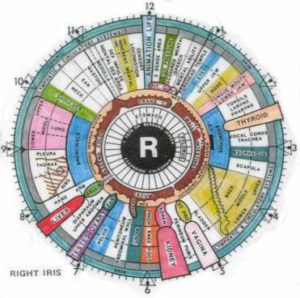History

Iridology Chart
The beginnings of iridology have been cited from many areas of the world dating back to the time of the early Chaldeans.
The first documented reference to iris analysis was when the physician Phillipus Meyens wrote a book called Chiromatica Medica published in 1679. This described the reflexive features of the iris part of the eye and gave an analysis of how it contained valuable information concerning the body and its related organs.
During the 19th Century, iridology as it became known, was further developed by Dr Ignatz von Peczley, a Hungarian physician. In 1881 von Peczley wrote a study of the eye with particular emphasis on the iris (the coloured part) and the pupil. He argued that by using microscopic analysis of these surface structures the health of the whole body could be determined.
He had been fascinated by the childhood memory of an experience he had as an 11 year old, when he was attacked by an owl, and in the ensuing fight the owl’s leg had been broken.
He had noticed that a small, dark stripe appeared in the lower part of the owl’s iris shortly afterwards. As the leg healed, the line was gradually replaced with white, crooked lines. The black stripe eventually became a tiny black spot, surrounded by white lines and shading. As an adult he began to investigate medical cases that appeared to mirror his experience with the owl. This led to the formulation of his theory of iridology.
In the 1950s, Dr Bernard Jensen pioneered the treatment in the USA and developed a comprehensive iris chart which showed the location of body organs reflected in areas of the eye.
Iridology is referred to as Opthalmic Somatology, Iris Analysis or Iris Diagnosis. Practitioners claim that it is only an analytical tool as opposed to a diagnostic tool due to the fact that only qualified doctors can diagnose disease or illness.
How Iridology Works
Iridology is a method of examining the iris of the eyes to obtain health information. It is considered by practitioners to be a form of reflexology and a science and is based on the assumption that diseases manifest themselves in signs, markings, structures, colourings and patterns that are visible in different parts of the iris. The iris itself is divided into sections, each one of which is connected to a particular body part.
The eye has thousands of nerve endings which are linked to all parts of the body but especially to the brain via the hypothalamus, the centre which controls the body’s vital processes. Iridologists believe that iridology works because the eye develops in the embryo as an extension of the forebrain and remaining part of the brain as well as being the specialised organ of sight. Therefore the iris receives impulses from all over the body. These nerve endings can indicate problems in bodily organs and systems.
The iris is said to provide accurate information about the constitutional type of a person and any tendencies towards particular health problems, thus it is an indicator of their strengths and weaknesses. It can also indicate pathological or functional disturbances such as deficiencies, imbalances, toxicity, inflammation, tissue congestion or abnormal tissue activity, immune defects and hereditary conditions. It can even reveal whether any imbalances are in the sub-acute, acute, chronic or degenerative stages.
As bodily tissues become inflamed or congested, the iris regulates the processes and enables the iridologist to determine the root cause of any disorder. The assumption is that the diseases manifest themselves in patterns which are visible in different parts of the iris. This is indicated by darkening of the mark or pattern which gradually becomes lighter as healing takes place – back to the owl! The belief is that as the cell structure in an organ or system changes, so the cell structure of the eye changes to reflect the health of that organ or system. For example, a toxic digestive system may be responsible for migraines, skin disorders or joint problems.
Consultation and Analysis
Firstly, questions are asked about the client’s lifestyle, health and medical history. Physical analysis is done by looking at the eye as a whole, then by focused observation of different areas of the eye for a few minutes using an iriscope (a magnifying glass and light). If the eye is looked at like the face of a clock, wherever marks or patterns are in the iris, these would indicate which part of the body had a health problem, eg kidney problems would show up in the right iris at about 5.30 and thyroid problems would be seen at 2.30.
An iridocamera may be used to take a picture of the eye and the image transferred to a computer so that comparisons can be made to assess any changes to the eye during subsequent consultations.
It is to be noted that iridology can highlight certain diseases such as rheumatoid arthritis which does lead to visible changes in the iris, however these are general changes throughout the iris and not the isolated changes claim by iridologists as the scientific basis of the practice.
Study Findings
Claims for the authenticity of iridology have been made by iridologists using data gathered from such sources as medical research that has allegedly been conducted in several European countries and in particular, Russia where a trial involving 800,000 patients found an 85% accuracy in diagnosis. They also state that in South Korea, clinical trials by the government found that on average iridology was 78.2% accurate but with an impressive 90.2% accuracy in the diagnosis of digestive system disorders.
However, Donal O’Mathuna, Ph.D and Walt Larimore, MD in their book ‘Alternative Medicine – The Christian Handbook’, state:
“No scientific evidence supports any of the connections proposed between the patterns of the iris and the parts of the body. A small number of studies found that the diagnoses made by iridologists are neither accurate nor consistent from one iridologist to another.”Belief in the ability of the therapist can become a self-fulfilling prophecy. If a person strongly believes that someone has the power to help that person, then he or she is much more likely to experience a placebo effect. It is a fact that one third of people given an inert compound to relieve a particular symptom will report relief of that symptom. This is called the placebo effect. Belief alone in the treatment will account for all the improvement seen in some people.
There is evidence that advocates of alternative medicine have become increasingly interested in iridology and offer it as part of, or in conjunction with, a whole range of New Age remedies. Iridology is already taught to medical students in certain European universities. In the USA, a professorship has recently been conferred on a Fellow of the Guild of Naturopathic Iridology by a leading medical teaching university. His role there is to instigate the teaching of iridology in particular plus other forms of complementary medicine. In addition, many web sites offer treatment as well as training courses for would-be practitioners of iridology alongside other holistic or alternative medical treatments.
Some patients, especially if open to suggestion from others that they ‘look better’, may simply imagine that they ‘feel better’; especially if the symptoms were of a vague nature in the first place. Alternatively they may simply grow used to tolerating the symptoms and deduce that it is the symptoms rather than their tolerance of them which has changed.
Conclusion
Iridology is scientifically questionable, goes against well-established scientific knowledge and approaches and there is no evidence that it reliably helps in making diagnoses.
According to O’Mathuna and Larimore, iridology is harmless in that the practitioner only examines the eyes and it is more rooted in quackery than New Age philosophy. However, serious harm can be caused to a patient who has an actual illness or disease that is left undiagnosed and untreated. Any herbal remedies sold by iridologists may also have an adverse effect on the health of someone who does not need them.
Bibliography
Books
Alternative Medicine, The Christian Handbook, by Donal O’Mathuna, Ph.D and Walt Larimore, MD. Published 2001 by Zondervan Publishing House, Grand Rapids Michigan.
Website Articles
Kevala Centre for holistic health – The work of Dr Ignatz von Peczely
Kevala Centre for holistic health – The birth of Iridology
Triad Holistic – Therapy Related Holistic Therapies
Iridologists in Stoke Newington -Iridology
Christian Medical Fellowship – Alternative Medicine Part 1
I.Village – Restoring health with naturopathy

